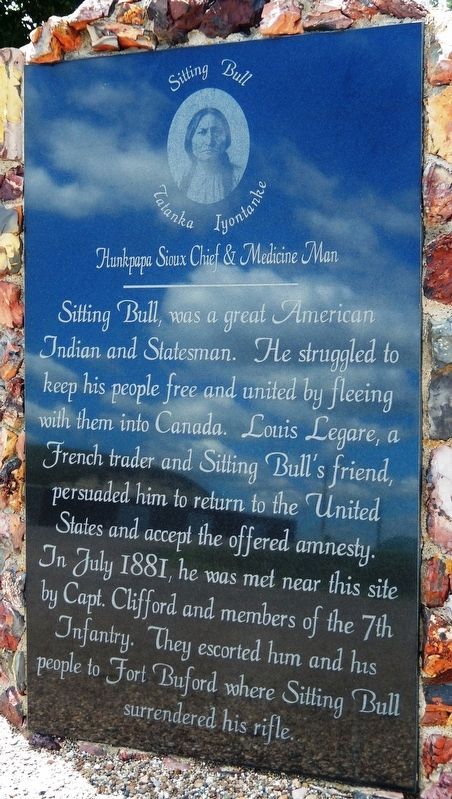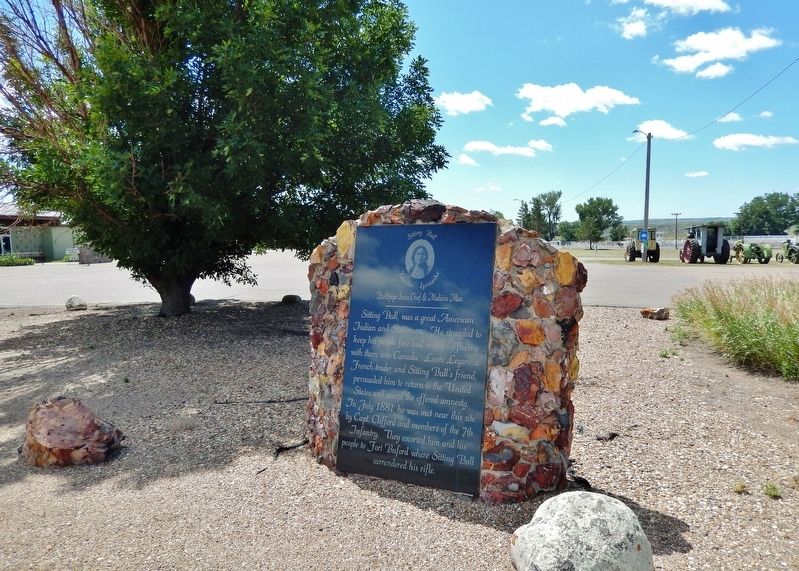Plentywood in Sheridan County, Montana — The American West (Mountains)
Sitting Bull / Tatanka Iyontanke
Hunkpapa Sioux Chief & Medicine Man
Sitting Bull was a great American Indian and Statesman. He struggled to keep his people free and united by fleeing with them into Canada. Louis Legare, a French trader and Sitting Bull’s friend, persuaded him to return to the United States and accept the offered amnesty.
In July 1881, he was met near this site by Capt. Clifford and members of the 7th Infantry. They escorted him and his people to Fort Buford where Sitting Bull surrendered his rifle.
Topics. This historical marker is listed in these topic lists: Forts and Castles • Native Americans • Peace • Wars, US Indian. A significant historical month for this entry is July 1881.
Location. 48° 46.26′ N, 104° 32.379′ W. Marker is in Plentywood, Montana, in Sheridan County. Marker is on East 1st Avenue (State Highway 16/5) 0.3 miles east of Lavalley Street, on the right when traveling east. Marker is located at the Montana Highway 16 Rest Area adjacent to the Sheridan County Fairgrounds entrance. Touch for map. Marker is at or near this postal address: 4255 Montana Highway 16, Plentywood MT 59254, United States of America. Touch for directions.
Also see . . .
1. The Battle of Little Bighorn.
In the wake of The Battle of Little Bighorn, the incensed U.S. government redoubled their efforts to hunt down the Sioux. At the same time, the encroachment of white settlers on traditionally Indian lands greatly reduced the buffalo population that the Sioux depended on for survival. In May 1877, Sitting Bull led his people to safety in Canada.(Submitted on July 28, 2022, by Cosmos Mariner of Cape Canaveral, Florida.)
2. Surrender.
Hunger and desperation eventually forced Sitting Bull and 186 of his family and followers to return to the United States and surrender on July 19, 1881. Sitting Bull had his young son Crow Foot surrender his Winchester lever-action carbine to Major David H. Brotherton, commanding officer of Fort Buford. Sitting Bull said to Brotherton, "I wish it to be remembered that I was the last man of my tribe to surrender my rifle". Two weeks later, after waiting in vain for other members of his tribe to follow him from Canada, Sitting Bull and his band were transferred to Fort Yates, the military post located adjacent to the Standing Rock Agency.(Submitted on July 28, 2022, by Cosmos Mariner of Cape Canaveral, Florida.)
Credits. This page was last revised on July 28, 2022. It was originally submitted on July 28, 2022, by Cosmos Mariner of Cape Canaveral, Florida. This page has been viewed 395 times since then and 97 times this year. Photos: 1, 2. submitted on July 28, 2022, by Cosmos Mariner of Cape Canaveral, Florida.

